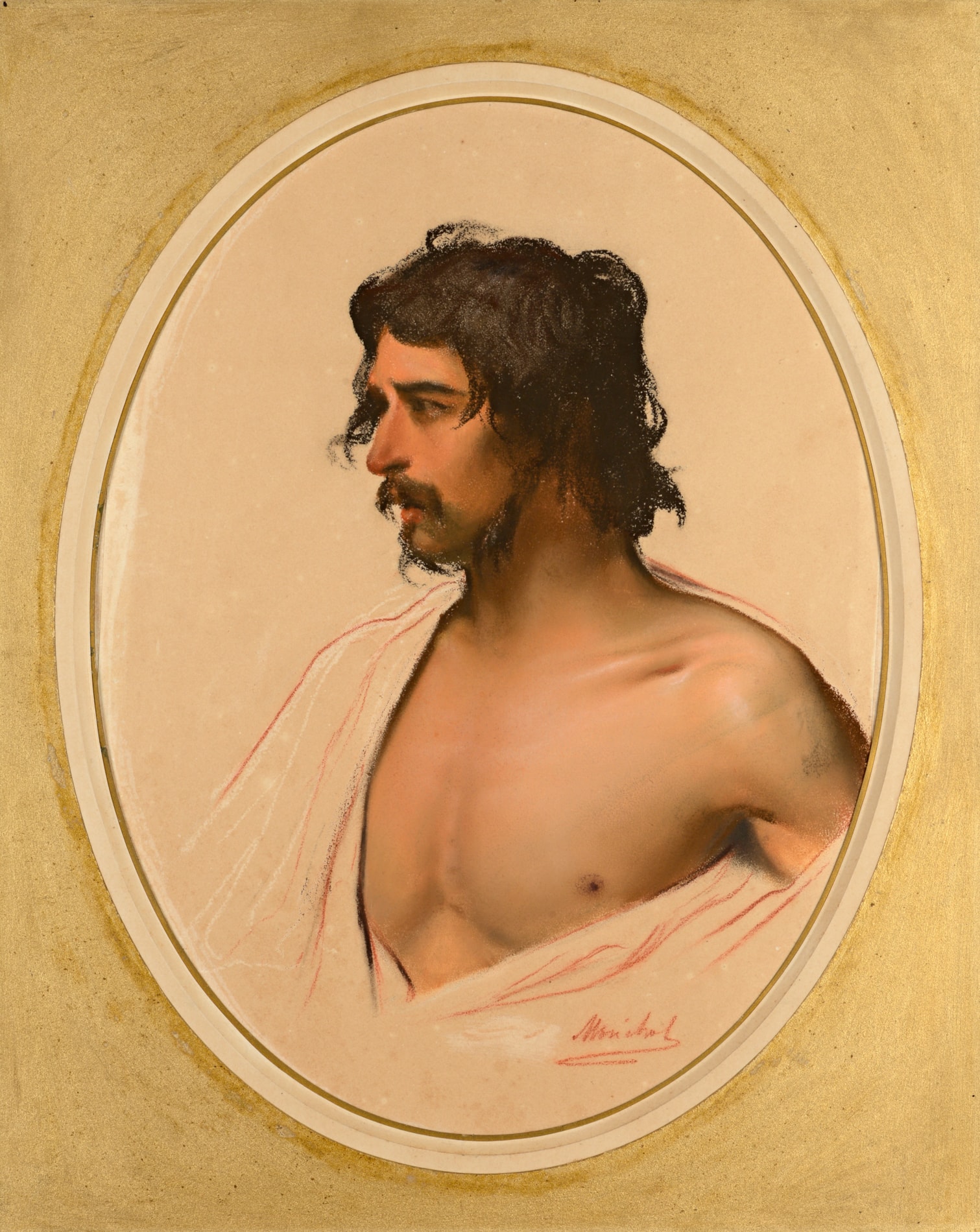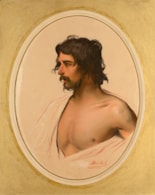Charles-Laurent MARÉCHAL
(Metz 1801 - Bar-le-Duc 1887)
Study of a Man
Sold
Charcoal, pastel, red and white chalk on buff paper. Oval.
Signed Maréchal in red chalk at the lower right centre.
421 x 313 mm. (16 1/2 x 12 1/4 in.) [image]
457 x 325 mm. (18 x 12 3/4 in.) [sheet]
Signed Maréchal in red chalk at the lower right centre.
421 x 313 mm. (16 1/2 x 12 1/4 in.) [image]
457 x 325 mm. (18 x 12 3/4 in.) [sheet]
The second half of his career found Maréchal working frequently in pastel, depicting genre subjects, portraits and landscapes. Among the pastels by the artist in public collections is a very large and highly finished composition depicting two peasant women cowering in fear of a wolf, exhibited at the Salon of 1876 and today in the Louvre, while a copy in pastel by Maréchal after a detail of one of the paintings in Rubens’s Marie de Medici cycle is in the Musée Barrois at Bar-le-Duc. A number of other pastels by Maréchal are today in the museum in Metz, while a splendid pastel portrait of the Hungarian composer and pianist Franz Liszt, dated 1840, is in the collection of the Richard-Wagner-Museum in Bayreuth.
Born into poverty, Charles-Laurent Maréchal (known as Maréchal de Metz) was trained as a saddler in his native Metz but began studying painting in the studio of Jean-Baptiste Regnault in Paris. In 1825 he returned to Metz, where the following year he won a second-class silver medal at the Exposition of the Departément of the Moselle for a painting of Job. Other paintings followed over the next few years, including a painting entitled Prayer that the artist presented to King Louis-Philippe on his visit to Metz in 1831, and an Apotheosis of Saint Catherine painted in 1842 for the cathedral at Metz. Maréchal eventually abandoned oil painting, however, in favour of the medium of pastel, which was better suited to his spirited technique. He exhibited a number of pastels at the annual Salons, with titles such as Hungarian Woodcutters, exhibited in 1840, and The Little Gypsy, shown the following year. Maréchal was recognized as the leader of a local school of artists that flourished in Metz between 1834 and 1870, and which was christened the ‘École de Metz’ by the poet Charles Baudelaire in 1845. Inspired by the work of Eugène Delacroix and the medieval past of Metz, as well as the Romantic landscape of the surrounding area, this group of artists, of whom Maréchal was the best-known, was disbanded following the Franco-Prussian War and the annexation of the city by Germany in 1871.
Maréchal is perhaps best known, however, as one of the most significant painters in stained glass of his day. A number of stained glass designs, exhibited at the Exposition Universelle of 1851, won him a first-class medal, while two large hemicycles executed for the Palais de l’Industrie in Paris in 1855 earned the artist the rank of Officer of the Legion of Honour. Maréchal painted stained glass windows for several churches in Paris, including Saint-Vincent-de-Paul, Sainte-Clothilde, Saint-Jacques-du-Haut-Pas and Saint-Germain-l’Auxerrois, as well as for the cathedrals of Cambrai, Limoges, Metz and Troyes and numerous smaller churches. It has been estimated that, over the course of his long career as a maître-verrier, Maréchal was responsible for the design of some 57,000 square metres of stained glass in over 1,500 churches. His son, Charles-Raphaël and daughter Hélène were also painters




